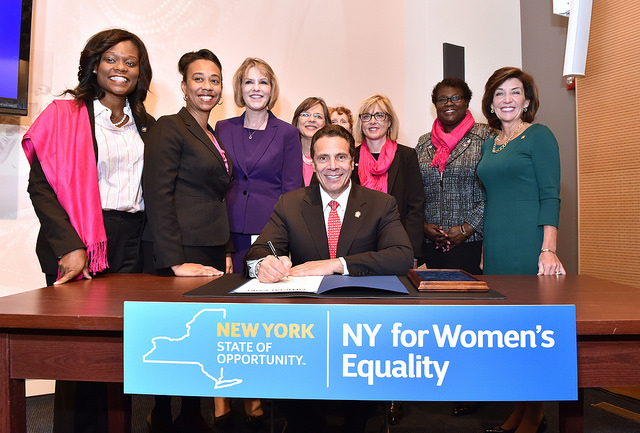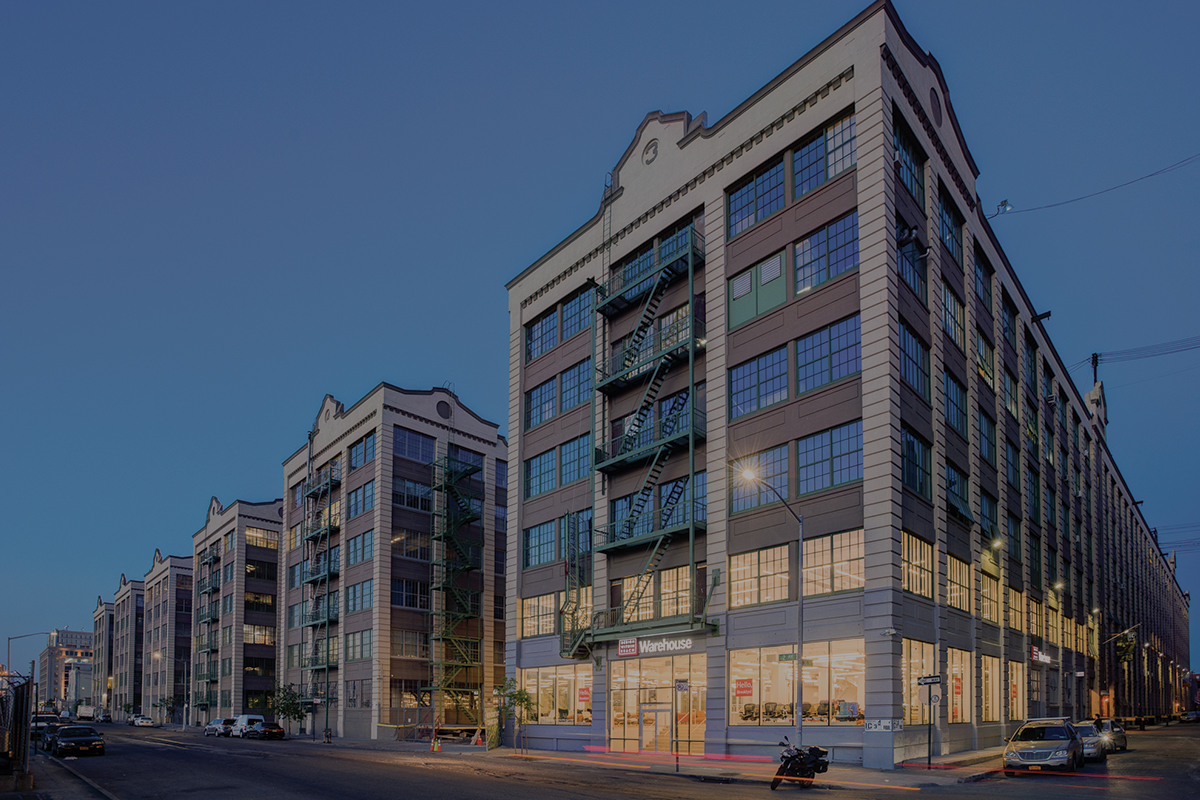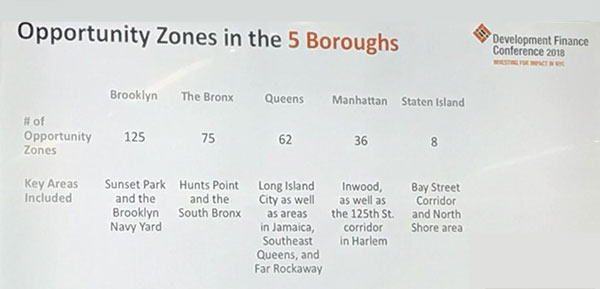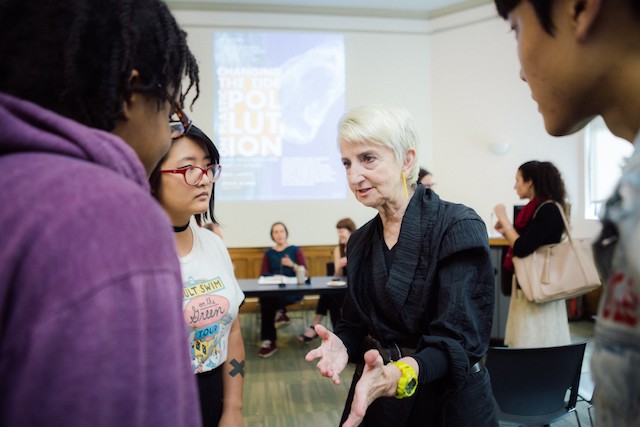Keep the Party Dedicated to Women’s Equality Alive in New York

Gov. Cuomo signs legislation (photo: Kevin P. Coughlin/Governor's Office)
Never has the time to stand up against the attacks on women and people of all races and religions been more important. Since the election of Donald Trump, it has been critically important to protect women’s rights against the barrage of attacks including assaults on reproductive rights, attempts to restrict access to healthcare, verbal abuse towards women, and the fight for representation on the Supreme Court.
The President of the United States publicly mocks victims of sexual assault. The Majority Leader of the U.S. Senate calls survivors of sexual assault and rape “clowns!”
Did you know one in five women will be raped and one in three women will experience some form of sexual violence in their lifetime? Annually, rape costs the U.S. $127 billion, more than any other crime. Nearly three women are murdered every day in the U.S. by current or former romantic partners. More than half of female homicide victims were killed in connection to violence by an intimate partner. During their lifetimes, 81% of women will experience some form of sexual harassment, with more than three out of four women experiencing verbal harassment.
During his first week in office, President Trump began issuing executive orders that reinstated the ‘Global Gag Rule.’ This Reagan-era policy bans international organizations that receive U.S. funding from providing abortion services or offering information about the procedure.
Last week, the Trump administration announced that it was expanding protections for doctors, nurses and other health care workers who have a moral or religious objection to performing abortion services. President Trump has appointed prominent anti-choice activists to high-level positions within the administration, and, of course, the appointments of anti-choice judges to the Supreme Court is the greatest threat to women’s right to choose.
But this is not just an anti-choice attack. The repercussions are serious and wide-ranging: rollbacks on no-copay contraception and maternity care are already taking place, and accessible health care for low-income children is at risk. Planned Parenthood is sometimes the only women’s health care provider in rural counties, offering maternal care, cancer screenings, and more. Those life-saving services are now being threatened.
Never before has the Women’s Equality Party of New York State been more critical. New York State Election Law provides that a party will exist if it receives at least 50,000 votes for its gubernatorial candidate on its party line. Four years ago, Governor Cuomo created the Women’s Equality Party (WEP) and received 53,000 votes on its line. The most important thing New Yorkers can do to ensure the continued existence of the Women’s Equality Party, the only women’s party in the nation, is to vote for Governor Cuomo on the WEP line this year, and help toward more than 50,000 votes on Election Day.
The Cuomo administration’s Women’s Equality Agenda advanced critical policies to protect domestic violence victims and prevent sexual assault on college campuses, legislation to remove guns from domestic abusers and to close a loophole in state law that will ensure domestic abusers are required to surrender all firearms, not just handguns.
The passage of the SAFE Act helps our children be safer in school during a time of mass school shootings.
The passage of an increased minimum wage and paid family leave is critical in lifting up the millions of women and children living in poverty, among many other New Yorkers.
These issues, along with others of importance to women and children, are detailed on the Women’s Equality Party newly launched website, which I encourage you to review ahead of casting your ballot on Tuesday.
The WEP aims to fight the policies designed to take back hard-fought rights gained over years of organizing and legislative battles. We need your help to keep our voice strong and in the fight. All of the WEP-endorsed federal, state, and local candidates will fight to protect women and children.
The 100th anniversary of women’s right to vote is in 2020. Women fought long and hard at great personal sacrifice to win this right. Now, in New York, women finally have a ballot line dedicated to their issues. We need to preserve this ballot status and grow our voice. We will march, speak up, and win political office. We will break glass ceilings everywhere. Most importantly – we will never go back!
***
Susan Zimet is Chair of the Women’s Equality Party of New York State.
***
Have an op-ed idea or submission for Gotham Gazette? Email This email address is being protected from spambots. You need JavaScript enabled to view it.
Supercharging the Gentrification of Sunset Park

Industry City (via Industry City)
In anticipation of the Department of City Planning’s certification of Industry City’s rezoning proposal, Community Board 7 has been hosting a series of town halls to inform and engage the public in discussions about Sunset Park’s waterfront. Four town halls have already taken place and on Monday, CEO Andrew Kimball will present Industry City’s rezoning proposal.
Undoubtedly, we will hear how Industry City’s proposed Special Sunset Park Innovation District, which entails the development of two hotels, academic space, and expanded retail, will create opportunity for neighborhood residents and small business owners. We will hear that Industry City tenants have already created thousands of jobs and that the Innovation Lab is connecting hundreds of Sunset Park residents to these jobs. Despite a community advocate and blogger’s repeated requests for evidence to substantiate these claims, Industry City has not yet shared any supporting data.
Kimball will likely elaborate how Industry City’s rezoning advances Community Board 7’s 197-a plan, “New Connections, New Opportunities,” adopted by the New York City Council in 2011. He will most likely bring out Industry City tenants, perhaps the same ones who attended my presentation at the October 1 town hall, to testify about Industry City’s positive community impact in cleaning up the waterfront and assisting local small business owners.
He may also discuss Industry City’s recent tri-lingual mailer publicizing its website. The mailer includes a pre-paid, addressed form [to Atlas Direct Mail] for recipients to simply check boxes and return stating their support for Industry City’s proposed plan. Since the mailer lacks any detail on the rezoning proposal, its emphasis on opportunity feels like a cheap gimmick to win the support of a community in need of meaningful employment with livable wages.
While substantive, long-term benefits to Sunset Park’s working class and working poor communities are questionable, the scale of real estate speculation and private investment unleashed by Industry City’s reactivation and related public relations hype is not. Kimball notes the rezoning will facilitate a $1 billion investment and add 1.3 million square feet of new development to Industry City by 2026.
In a July 2017 Progressive City article, I documented Kimball’s affinity for transnational capital in his public and private roles as a steward of Brooklyn’s industrial properties. I detailed Industry City’s recapitalization of its mortgage with a massive loan from the Bank of China [one of China’s “Big Four” state-owned banks] with more capital to be distributed over time as Industry City is renovated and leasing goals are met.
At a September NYC EDC development finance conference, I learned Sunset Park is targeted for more infusion of private capital. A panel titled, “Beyond Bonds: New Investment Tools Catalyzing Growth,” introduced Opportunity Zones – a federal census tract designation created by Trump’s 2017 Tax Cuts and Jobs Act. Trump’s tax cut act provides a historic reduction in the corporate tax rate as well as lowered taxes for high net worth individuals. Through Opportunity Zones, the wealthy can defer capital gains taxes by investing in businesses or property development in “economically distressed” communities defined as census tracts with a 20 percent or higher poverty rate and a median family income no greater than 80 percent of the area median.
Sixty percent of New York State’s 514 designated Opportunity Zone census tracts are located in New York City. The highest concentration of the city’s Opportunity Zones is in Brooklyn [with 125 designated census tracts] and many are clustered in the “key areas” of Sunset Park and the Brooklyn Navy Yard.

Eleven Sunset Park census tracts are designated Opportunity Zones. While the bulk of Industry City’s massive 16-building complex is located in census tract 18 which is not an Opportunity Zone, surrounding waterfront census tracts that include two Industry City block lots - Block 695, Lots 20 and 43 – are designated Opportunity Zones.
Source: NYC Empire State Development, Brooklyn Federal Opportunity Zones
Most notably, census tract 2 is an Opportunity Zone and includes Block 695, Lots 20 and 43, as well as six properties that Industry City intends to acquire and demolish for its proposed 12-story Gateway Building with ground floor retail and 11 stories of hotel space. These six properties – 950, 952, 954, 956, 958 and 960 Third Avenue – are located between 36th and 37th Streets and, according to the city’s building classifications, they are primarily two-family buildings with ground-level retail.
Census tract 2 exemplifies the defining criteria of an Opportunity Zone with a poverty rate of 31% and a median family income of $46,964. Moreover, the census tract’s 1,600 residents are majority Latino (90%), renters (82%), and lack a high school diploma (59%). Opportunity Zone designation, however, will mean opportunity for private investors to benefit from tax breaks by underwriting Industry City’s hotel and retail Gateway development. Sunset Park’s Opportunity Zones will supercharge the gentrification already taking hold in and around Industry City.
In addition to the waterfront, Sunset Park’s census tract 118 includes two proposed mega-developments on 8th Avenue and is also a designated Opportunity Zone. One of the proposed projects is the Eighth Avenue Center adjacent to the N subway station. Community Board 10 and Sunset Park stakeholders have already expressed opposition to this “ginormous” development. Directly across 8th Avenue is another huge development site that involves the sale of MTA air rights. Developers will surely benefit from the Opportunity Zone designations and the potential infusion of financing for their luxury housing, hotels, and commercial real estate projects.
Industry City and Eighth Avenue Center’s rezonings will undoubtedly catalyze transformative neighborhood change. Augmented by Opportunity Zones, Sunset Park is facing a potential financial superstorm that will supercharge gentrification and displace the multi-racial, multi-ethnic working class populations and small businesses including industrial businesses that have long defined this neighborhood.
***
Tarry Hum is a professor at The City University of New York (CUNY) and author of Making a Global Immigrant Neighborhood. On Twitter @TarryHum.
***
Have an op-ed idea or submission for Gotham Gazette? Email This email address is being protected from spambots. You need JavaScript enabled to view it.
Solving Problems by Bridging Community and Higher Education

Frances Bronet, one co-author, during an event of Pratt’s "Blue Week" (photo: Pratt)
Across the country, the shortage of affordable housing and rising homelessness threaten the vitality of our cities as areas of opportunity and centers for commerce, creativity, learning, and a foundation for our sense of identity. Educational institutions should be active partners addressing these issues in their cities and communities.
When Chhaya CDC, Cypress Hills LDC, and other community groups in Queens and Brooklyn identified informal basement apartments as both a challenge to the health and safety of their residents and also a chance to create safe affordable housing, we saw an opportunity to serve, by leveraging the expertise of Pratt Institute faculty and students through our Pratt Center for Community Development to examine and help the community groups realize their vision.
A new pilot project announced earlier this year with the support of City Council Members Inez Barron, Rafael Espinal, and Brad Lander in partnership with Mayor Bill de Blasio will make East New York the first neighborhood in New York City to test specific new measures designed to ensure the safety of tenants and legalize many basement apartments.
By legalizing apartments, residents will be empowered to finally demand leases and can be confident that their unit is safe for themselves and their families.
For lower- and moderate-income homeowners who rent out part of their homes to bring in extra money to help cover their bills, the city will provide assistance to enable them to properly outfit their basement units to meet new fire and safety code standards.
This was a major achievement for the community and an important step toward addressing their housing needs as well as protecting the residents of as many as 110,000 basement units in New York City.
As a 130-year-old New York institution, we constantly ask ourselves what can we do to ensure more New Yorkers have a safe place to sleep at night, and how can we support our city’s continued vitality and provide better models for other cities?
Over the past 50 years, Pratt Center, which grew out of the School of Architecture, has worked with dozens of community groups providing research and planning expertise to support their efforts to rebuild thousands of units of affordable housing, retrofit homes for energy efficiency, improve mass transit, and build sustainable communities.
There’s no shortage of urban issues that require new ways of thinking and much greater collaboration. With New York City’s population nearing nine million residents, failing to address current challenges on critical issues like transit, homelessness, and environmental justice today will cause even greater inequities over the long term if left unchecked.
Another critical piece to creating thriving communities is, of course, jobs. As educators, one of our most essential responsibilities is to prepare our students for the future workforce, including those positions and trajectories that we can’t even yet imagine.
Beyond empowering our students to be outspoken advocates against injustice and to be true thinkers, we want them to feel confident in their ability to succeed when they leave campus—in whichever direction life takes them.
One of the best ways of teaching and instilling confidence is by real world problem-solving. Through the Made in NYC initiative, we’re pairing Pratt students in photography, videography, and design with local manufacturers to create “communications assets” to help these businesses tell their stories, expand their markets, and create jobs.
This initiative has been so successful that the City Council stepped in with additional funding to grow the program, which is now serving 1,250 local businesses. We must continue to expand efforts like these, which are being piloted and led by private institutions citywide.
Educational institutions have a unique opportunity to drive partnership because of the expertise of their faculty and students, and their mission to employ critical research and fact-based decision-making.
With a new administration here at Pratt, we renew this commitment. We look forward to building on our past successes and collaboratively solving today’s challenges (and those that don’t yet exist). To our neighbors across New York, from Midtown Manhattan to the outermost parts of the boroughs, we are here for you—and want to collectively create a better New York.
Stay tuned as we step up for New York in big ways. It is how we teach, how we learn, and how we drive positive change together.
***
Frances Bronet is the 12th President of Pratt Institute. Adam Friedman is the Director of the Pratt Center for Community Development. On Twitter @PrattInstitute.
***
Have an op-ed idea or submission for Gotham Gazette? Email This email address is being protected from spambots. You need JavaScript enabled to view it.




